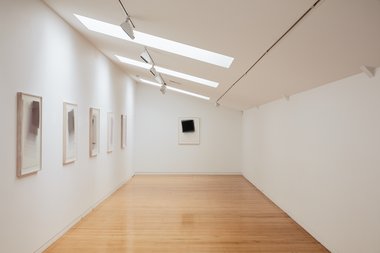John Hurrell – 28 March, 2019
It all comes from an improvised process involving tight eye/hand co-ordination, where carefully shaped puddles of liquid colour are placed on the dense handmade paper and removed with precise control. The time taken in between—for the paper to retain stains of thin colour—is meticulously estimated.
It is about eight years since Joachim Bandau last had an exhibition of his watercolours at Two Rooms, and this show provides a good chance to think about his works on paper, especially as in Europe he is known primarily as a sculptor and maker of lacquer paintings.
Even if he wasn’t, it has often been observed that in Europe the large community of collectors can for a long time, support artists working through simple ideas or limited techniques that in New Zealand much smaller groups would soon tire of. In Aotearoa there is more commercial pressure on local artists to change.
These marvellously delicate works with their illusory spatial manipulation and interest in transparency and overlapping planes, are made with a large brush and washes of liquid watercolour that are soaked up and removed with blotting paper to leave extremely thin traces of dried residue on the rectangular perimeters. There are no pencil lines, so technically the images are pretty mysterious.
Your initial thoughts might be whether he uses a template or stencil, or a masking technique with tape or emulsion? In fact none of these apply—it all comes from an improvised process involving tight eye/hand co-ordination, where carefully shaped puddles of liquid colour are placed on the dense handmade paper and removed with precise control. The time taken in between—for the paper to retain stains of thin colour—is meticulously estimated.
As compositions, these elegant watercolour drawings look like stacked up or spread out sheets of glass—with vaguely smoky, ghostly shadows—but coloured with a range of warm greys, and no traces of blue or green. The bundles of wash-infused quadrilaterals result in intricate clusters of long (subtly wobbly) lines converging or splaying, introducing a tonally inflected drama of linear tensions, with vectors expanding or contracting. These are counterbalanced by dark shapes pulling your eyes to the paper’s edges and corners, while you enjoy the crisp formal geometry and glowing planar expanses—with barely detectable wispy shadows.
John Hurrell








 Advertising in this column
Advertising in this column Two Rooms presents a program of residencies and projects
Two Rooms presents a program of residencies and projects



This Discussion has 0 comments.
Comment
Participate
Register to Participate.
Sign in
Sign in to an existing account.